Location and history:
According to Ferguson, PRIA 9, 1867, 160 f., the "spot" was "marked with the name Owneygat, that is, the Cat's Cave" within "the townland of Glenballythomas" (this is Umhaid na gcat according to a ms. 14 F. 8, p. 191 ff., deposited in the Library of the Academy; Herity, Rathcroghan, 16 has "Oweynagat" and Uaigh na gCat instead. Another name was "Queen Meave's treasure-house" according to OI, 56). It is situated "310 yards ("30 yards westward" in OI) north-west of the ancient sepulchral enclosure called Relig-na-ree" which is believed to have been the cemetery of the Cruachu kings. In his article about "Cemeteries" (PRIA 15, 1872), 117, Ferguson stated that "about three hundred yards to the south-east of Relig-na-ree stands the pillar-stone thought to indicate the grave of Dathi, the last Pagan Monarch of Ireland, who is recorded to have been buried at Rathcroghan A.D. 428". Cf. Ferguson, PRIA 15, 1872, 114-118 for details about the whole site as well as figures showing the Relig-na-ree and Dathi's pillar; the first description can, according to PRIA 9, 1867, 160, be found in a note to O'Donovan's translation of the "Annals of the Four Masters", for A.D. 1223. A thorough description has recently been published by M. Herity; cf. his "Rathcroghan and Carnfree".
The site was visited by Ferguson on the 30.9.1864 (PRIA 9, 1867, 161) who "observed" (for the first time?) two "inscriptions in the Ogham character" in the souterrain. According to him, the cave was surrounded by "the remains of a tumulus of about twenty yards in diameter" at that time (cp. his
 Fig. 1, where "A" marks the entrance as shown in his Figs.
Fig. 1, where "A" marks the entrance as shown in his Figs.  4 and
4 and  5). Today, the tumulus no longer exists, the entrance being hidden underneath the path mentioned (cp.
5). Today, the tumulus no longer exists, the entrance being hidden underneath the path mentioned (cp.  photograph 9). If compared with Ferguson's description, the souterrain cannot be entered to the same extent as in his days now because it has filled up with mud (cp.
photograph 9). If compared with Ferguson's description, the souterrain cannot be entered to the same extent as in his days now because it has filled up with mud (cp.  photograph 6). The present stone (numbered 12 by Macalister, CIIC), is still in reach, however.
photograph 6). The present stone (numbered 12 by Macalister, CIIC), is still in reach, however.An exact reading was not possible under the given circumstances when the cave was visited in 1978; in 1996, conditions were much better because the afternoon sunlight fell just into the entrance.
No size is given by Macalister, CIIC.
The stone is not included in Macalister, Epig.
- Published illustrations:
- Ferguson, PRIA 9, 1867, 162 ff. (three woodcuts, no.
 1,
1, 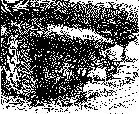 2,
2, 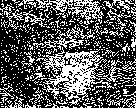 3, showing the structure of the souterrain,
3, showing the structure of the souterrain,  one draft showing the presumed original shape of the stone, and
one draft showing the presumed original shape of the stone, and  one sketch of the inscription);
one sketch of the inscription);- Herity, Rathcroghan, Pl. 2a, p.12 (photograph showing the entrance to "Oweynagat")
- Macalister, CIIC (draft).
- Herity, Rathcroghan, Pl. 2a, p.12 (photograph showing the entrance to "Oweynagat")
Reading Ferguson, PRIA 9, 1867, 168:
Outer angle, west to east | inner edge, west to east:
FRAICCI | MAQI MEDFFI
"(The stone of) [Fraic?] son of Medf."
The author wonders whether the "two ribbed projections, separated by shallow grooved indentations" he found on "the inner edge, at the eastern end" (i.e. after the letters read "FFI") might have resulted from intentional "preparation with the tool". He compares "similar indentations" on a stone from New Grange and one of the "Ogham inscribed stones in the Academy's Lapidarian Museum, No. 5" {142: Ballineanig}. "These indentations, whatever object they may have had, appear to indicate that this is the upper end of the stone, and raise a probable conjecture that it originally stood upright."
Reading Ferguson, OI 57 (83.-84.):
83.: Outer arris:FRAICCI / FREOCCI
84.: Inner arris:
MAQIMEDFFI
Maqi Medffi
Interpretation Macalister, JRSAI 27, 1897, 231:
VRAICCI MAQI MEDVVI
Interpretation McNeill, PRIA 27/C, No. 15, 1909, 345:
MEDVVI
Reading Macalister, CIIC:
VRAICCI MAQI MEDVVI
Interpretation Korolev, DP, 60:
VRAICCI MAQI MEDVVI
Interpretation Herity, Rathcroghan, 16:
VRAICCI ... MAQI MEDVVI
Reading Gippert (5.4.1996):
"Outer" angle
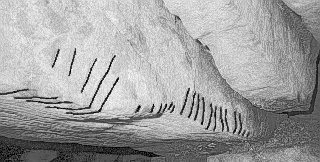 "west" to
"west" to 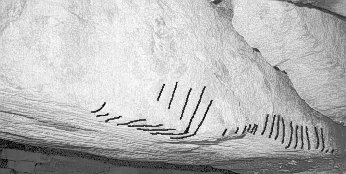 "east" -
"east" -"Inner" angle
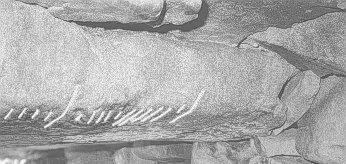 "west" to
"west" to 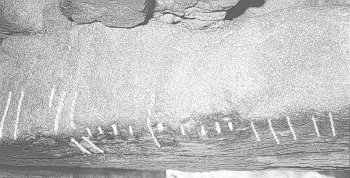 "east":
"east":(V)RAICC(I) [||] MAQI MEDVV(I)
(ᚃ)ᚏᚐᚔᚉᚉ(ᚔ) [||] ᚋᚐᚊᚔᚋᚓ(ᚇᚃ)ᚃ(ᚔ)
(ᚁ)ᚁᚁᚋᚋᚋᚋᚋᚐᚐᚐᚐᚐ(ᚐ) [||] ᚋᚐᚆᚆᚆᚆᚆᚐᚐᚐᚐᚐᚋᚐᚐᚐᚐᚆᚋᚁ(ᚁ)ᚁᚁᚁ(ᚐᚐᚐᚐᚐ)
 5); we might therefore rather think of the D having been added later, either as an insertion into an original *MEVVI or as a correction of a misspelt *MELVI. The latter possibility is suggested by the fact that the third stroke of the first V in the name is much shorter than the V1,2 and does not reach the angle so that it is doubtful by itself.
5); we might therefore rather think of the D having been added later, either as an insertion into an original *MEVVI or as a correction of a misspelt *MELVI. The latter possibility is suggested by the fact that the third stroke of the first V in the name is much shorter than the V1,2 and does not reach the angle so that it is doubtful by itself.- JRSAI 28, 1898, 230; 409: Rhys
- PRIA 9, 1864-66, 160-170: Ferguson
- JRSAI 113, 1983, 121-42 / 114, 1984, 125-138 / 117, 1987, 125-142 / 118, 1988, 67-84: Herity
- JRSAI 41, 1911, 93-116 / 105-240 / 301-342: Knox
- JRSAI 44, 1914, 1-50 / 48, 1918, 157-163: Knox
- Ó Ríordáin, S.P., Antiquities of the Irish Countryside (5th ed., 1979)
- Journ.Ir.Arch. 1, 1983, 21-46: Waddell
- Emania 5, 1988, 5-18: Waddell
- PRIA 9, 1864-66, 160-170: Ferguson